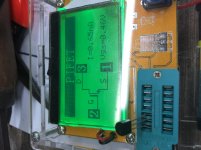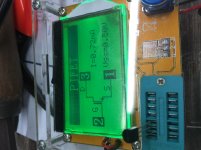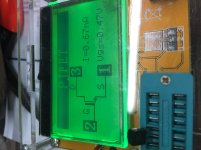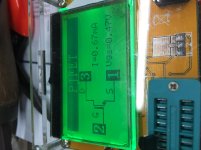Ahh... you learn by doing.
You learn even more by setting on fire, but we'll get to that later....
You learn even more by setting on fire, but we'll get to that later....
I think you all got some experience with it, lol 😀Ahh... you learn by doing.
You learn even more by setting on fire, but we'll get to that later....
Hi all, a couple questions as I begin gathering parts for the Aleph J:
1. I'm working on my Mouser cart for parts to supply the boards. I entered the Vishay RN60 resistors, but notice they're rated at 1/8 watt rather than the 1/4 watt listed in BOMvD. Should I go with the CMF55s instead at 1/2 watt or does it not matter that much?
2. I'm planning to use the DIY Audio Store PSU with either Antek AS-3220 or 4220 (18v are out of stock). My plan is to start with a regular single power supply, listen for a while, and then transition to dual mono (going to build in 5U chassis). I also like the idea that others have mentioned of building a power supply that can work with other First Watt boards. With those longer term goals in mind, I'd appreciate any guidance on parts to select for the PSU.
3. Finally (for now), does anyone know of a source for the output MOSFETs, or if the transistor kit will be back in stock in the store anytime soon?
Thanks!
1. I'm working on my Mouser cart for parts to supply the boards. I entered the Vishay RN60 resistors, but notice they're rated at 1/8 watt rather than the 1/4 watt listed in BOMvD. Should I go with the CMF55s instead at 1/2 watt or does it not matter that much?
2. I'm planning to use the DIY Audio Store PSU with either Antek AS-3220 or 4220 (18v are out of stock). My plan is to start with a regular single power supply, listen for a while, and then transition to dual mono (going to build in 5U chassis). I also like the idea that others have mentioned of building a power supply that can work with other First Watt boards. With those longer term goals in mind, I'd appreciate any guidance on parts to select for the PSU.
3. Finally (for now), does anyone know of a source for the output MOSFETs, or if the transistor kit will be back in stock in the store anytime soon?
Thanks!
RN60, CMF60, CMF55, RN55 are all fine. The rating diff between RN and CMF
series has to do with RN having a mil-spec rating. There was a recent discussion
on this issue:
Vishay Cmf55 vs Rn55
The FW amps (say, from F4 and on, and including the AJ) all use pretty
much the same PS.). Between AS3220 and AS4220 I would pick the 400VA
one. It would work well right now and isn't much bigger than the 300VA one,
so fitting two in the chassis when you go dual mono should not be a problem.
No idea about the availability of the output mosfets. Try contacting
the store to see if there's an ETA. Or you can try matching them yourself as a
learning experience.
Cheers,
Dennis
series has to do with RN having a mil-spec rating. There was a recent discussion
on this issue:
Vishay Cmf55 vs Rn55
The FW amps (say, from F4 and on, and including the AJ) all use pretty
much the same PS.). Between AS3220 and AS4220 I would pick the 400VA
one. It would work well right now and isn't much bigger than the 300VA one,
so fitting two in the chassis when you go dual mono should not be a problem.
No idea about the availability of the output mosfets. Try contacting
the store to see if there's an ETA. Or you can try matching them yourself as a
learning experience.
Cheers,
Dennis
What Dennis said. 
The RN are 100% derated to meet the milspec, which means they are 1/4w resistors that say 1/8w on the datasheet.
There’s an article on matching mosfets on the Pass DIY website that Nelson wrote. It’s not hard and you could use a laptop charger as the PSU. Buy a stick, which is 25, match them up, and sell the others on swap meet. Remember in the AJ you only need to have pairs that are next to each other matched. I.E., you could have 4 pairs in a stereo AJ and everything will work and sound perfect.

The RN are 100% derated to meet the milspec, which means they are 1/4w resistors that say 1/8w on the datasheet.
There’s an article on matching mosfets on the Pass DIY website that Nelson wrote. It’s not hard and you could use a laptop charger as the PSU. Buy a stick, which is 25, match them up, and sell the others on swap meet. Remember in the AJ you only need to have pairs that are next to each other matched. I.E., you could have 4 pairs in a stereo AJ and everything will work and sound perfect.
Thanks, Dennis and 6L6!
Hmm, I just might try my hand at matching... 6L6, when you say "buy a stick", do you mean just order 25 mosfets from, say, Mouser? Or is there a specific place one goes to buy a stick of mosfets?
Also, is there anything I should keep in mind as far as parts values go for the AJ so that it pairs well with my BA3-FE pre? I'm assuming I'll need to adjust the BA3FE's output cap to match the impedance of the AJ... (it's currently set up for ACAs).
Hmm, I just might try my hand at matching... 6L6, when you say "buy a stick", do you mean just order 25 mosfets from, say, Mouser? Or is there a specific place one goes to buy a stick of mosfets?
Also, is there anything I should keep in mind as far as parts values go for the AJ so that it pairs well with my BA3-FE pre? I'm assuming I'll need to adjust the BA3FE's output cap to match the impedance of the AJ... (it's currently set up for ACAs).
Just order 25 from Mouser. Or digiKey. It’s very likely they will all be from the same wafer and will match nicely. (And anyway, the N channels match better than the P, generally speaking)
Your BA3 pre needs no changes. Nor does the AJ.
Your BA3 pre needs no changes. Nor does the AJ.
The IRFP240 mosfets come in rails of 25 pieces so getting one will ensure
they are from the same production lot.
To reiterate what 6L6 said earlier, you need only to get
matching pairs since the mosfets will be used in groups of two. (So you
don't need to look for a matched set of 8; you may get one if you're lucky)
You should get a good number of matching pairs.
Here's the article on matching that 6L6 mentioned:
http://www.firstwatt.com/pdf/art_matching.pdf
And this one on mosfet testing is interesting as well:
http://www.firstwatt.com/pdf/art_mos_test.pdf
Have fun!
Dennis
they are from the same production lot.
To reiterate what 6L6 said earlier, you need only to get
matching pairs since the mosfets will be used in groups of two. (So you
don't need to look for a matched set of 8; you may get one if you're lucky)
You should get a good number of matching pairs.
Here's the article on matching that 6L6 mentioned:
http://www.firstwatt.com/pdf/art_matching.pdf
And this one on mosfet testing is interesting as well:
http://www.firstwatt.com/pdf/art_mos_test.pdf
Have fun!
Dennis
Hi there. I’ve just received a new pair of JFETs from the Diyaudio store and they don’t appear to be as well matched as the two I just removed.. See attached pics of the new and old jfets. First two with long legs are the new pair. The old pair are within 0.01 and also appear to check out ok in the meter. Should I install the new JFETs ?
Attachments
Last edited:
Mega328 has a bit of an issue reading Jfets in my experience. Both of your sets are absolutely good enough to be used without hesitation in your project. One pair just happens to be matched so well as to be incredible.
You’ll never hear the difference...
You’ll never hear the difference...
Thanks 6L6. I might as well install the new ones. I suspect this won’t solve my -8v at the output terminal problem. I’ve eliminated every potentially suspect part suggested...
Can someone explain how would a different JFET saturation currents affect their usage in Alep J, please?
For example, one pair having Idss of 6mA (matched within 0.1mA tolerance margin)
....and...
the second pair having Idss of 11mA (matched within 0.1mA tolerance margin).
I read somewhere that the optimal Idss is around 8mA; is that true? Why is that?
For example, one pair having Idss of 6mA (matched within 0.1mA tolerance margin)
....and...
the second pair having Idss of 11mA (matched within 0.1mA tolerance margin).
I read somewhere that the optimal Idss is around 8mA; is that true? Why is that?
Last edited:
Woo hoo! I can now adjust my left channel offset to zero volts! Must have been a duff JFET. Even though the pair I removed looked perfect in the LCR meter...
Nice!
I think, from my memory, the JFETS have an area that works like a capacitor. When measuring the Idss, you bias that "capacitor" sufficient enough (pushes the capacitor into the conductive state), and it measures okay Idss-wise
The problem is related to very slight damage, that causes the JFET to misbehave at lower voltages. That damage is caused by electrostatic discharge.
Anyway, great that you got it going!!
I think, from my memory, the JFETS have an area that works like a capacitor. When measuring the Idss, you bias that "capacitor" sufficient enough (pushes the capacitor into the conductive state), and it measures okay Idss-wise
The problem is related to very slight damage, that causes the JFET to misbehave at lower voltages. That damage is caused by electrostatic discharge.
Anyway, great that you got it going!!
Ok, this got me thinking and I remembered another great trick I used during my days...
Whenever I suspected a faulty JFET with the symptoms as you have been having for a few weeks, this is what I used to do:
1. Insert few ohms’ resistors (same value for both, could be even 1 ohm): similar to degeneration resistors. This then allows me to measure the current through each JFET.
2. Touch with the probe, the gate of each JFET and then:
a) look for oscillations
and
b) look for an increased current run from common CCS, through a dodgy JFET that oscillates.
The above does not require removal of JFETS, with spot-on accurate results in finding a dodgy (slightly damaged) JFET
Same applies to figuring out the bad MOSFETS in the output stage; just touch the gate with a probe – the slightly damaged one will start oscillating like hell, and will pull much more current through its gate (source, depending on connection/circuit) resistor, compared to other ones.
Whenever I suspected a faulty JFET with the symptoms as you have been having for a few weeks, this is what I used to do:
1. Insert few ohms’ resistors (same value for both, could be even 1 ohm): similar to degeneration resistors. This then allows me to measure the current through each JFET.
2. Touch with the probe, the gate of each JFET and then:
a) look for oscillations
and
b) look for an increased current run from common CCS, through a dodgy JFET that oscillates.
The above does not require removal of JFETS, with spot-on accurate results in finding a dodgy (slightly damaged) JFET
Same applies to figuring out the bad MOSFETS in the output stage; just touch the gate with a probe – the slightly damaged one will start oscillating like hell, and will pull much more current through its gate (source, depending on connection/circuit) resistor, compared to other ones.
Woo hoo! I can now adjust my left channel offset to zero volts! Must have been a duff JFET. Even though the pair I removed looked perfect in the LCR meter...
Good gear.
Now to the listening test. All the best.
- Home
- Amplifiers
- Pass Labs
- Aleph J illustrated build guide



